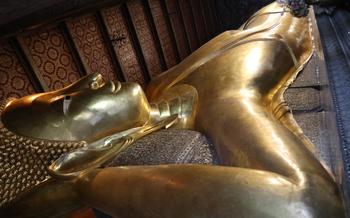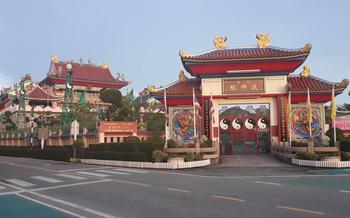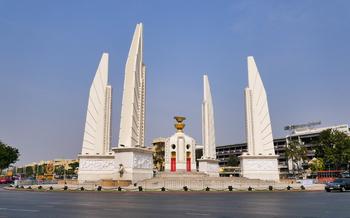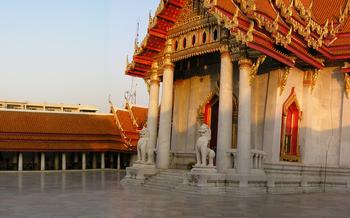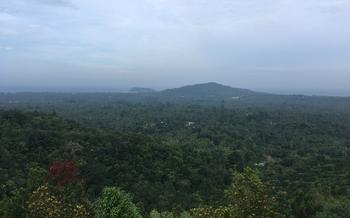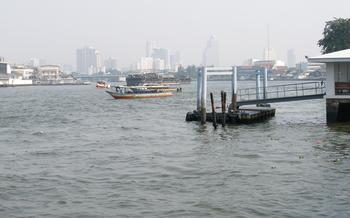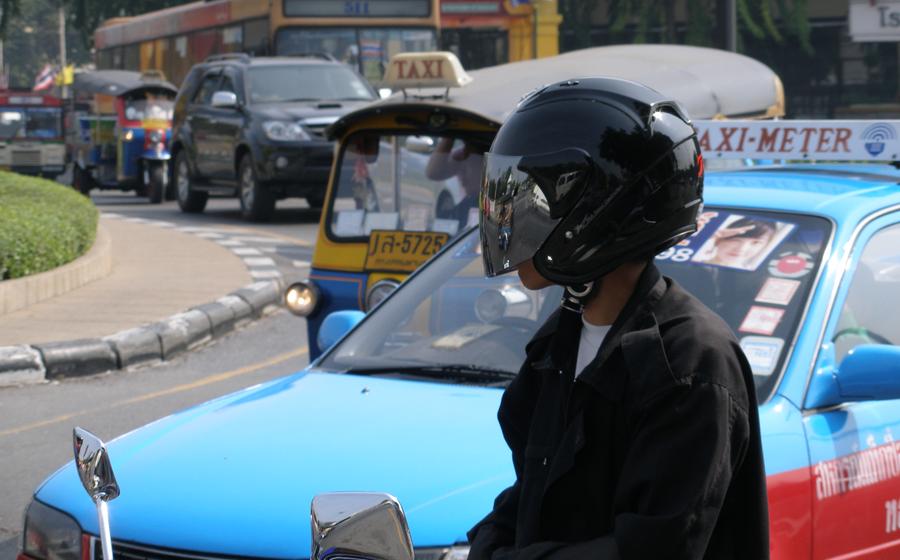
Wat Phra Kaew (Temple of the Emerald Buddha)
- A Temple of Stunning Beauty
- The Emerald Buddha
- Exploring the Temple Grounds
- The Royal Ceremonies
- Dressing Appropriately
- Respecting Temple Etiquette
- Booking a Guided Tour
- Photography Guidelines
- Souvenirs and Shopping
- Exploring the Surrounding Area
- Planning Your Visit
- Staying Hydrated
- Insider Tip:
A Temple of Stunning Beauty
Wat Phra Kaew, nestled within the heart of Bangkok's Grand Palace complex, is a testament to Thailand's rich cultural heritage and profound devotion to Buddhism. As the most sacred Buddhist temple in the country, it holds a unique place in the hearts of Thai people and attracts millions of visitors worldwide.
The temple's architectural splendor is immediately captivating, showcasing a harmonious blend of traditional Thai and Khmer influences. Its towering spires, intricate carvings, and gleaming stupas create a sense of awe and wonder. The temple's central chedi, known as the Phra Si Ratana Chedi, is adorned with colorful ceramic tiles and intricate designs, symbolizing Mount Meru, the sacred abode of the gods.
Wat Phra Kaew's location within the Grand Palace complex adds to its significance. The palace, once the residence of Thai kings, served as the center of royal power and religious ceremonies. The temple's proximity to the throne hall and other royal buildings highlights its close connection to the monarchy, which has been the guardian of Buddhism in Thailand for centuries.
Visiting Wat Phra Kaew is a truly immersive experience that leaves an indelible mark on the soul. The temple's beauty, serenity, and spiritual energy create an atmosphere of tranquility and reverence. As you wander through its sacred grounds, you can't help but feel a sense of awe and wonder, realizing that you are in the presence of something truly extraordinary.
The Emerald Buddha
The Emerald Buddha, also known as the Ph a symbol of the country's deep Buddhist faith. Carved from a single block of jade, the Emerald Buddha is believed to have been created in India in the 15th century before making its way to Thailand in the 18th century. Enshrined within the Temple of the Emerald Buddha, the statue is adorned with intricate gold garments and jewelry, reflecting its immense cultural and religious significance.
Legends and myths surround the Emerald Buddha, contributing to its mystique and allure. One legend tells of a miraculous discovery of the statue in northern Thailand in the 15th century, where it was found hidden inside a stupa that was struck by lightning. Another legend claims that the Emerald Buddha possesses supernatural powers, including the ability to bring rain during droughts and protect the kingdom from harm.
Thai people hold the Emerald Buddha in the highest esteem and pay homage to it regularly. During significant Buddhist holidays and festivals, elaborate ceremonies are held at the temple, where devotees offer prayers, make offerings, and seek blessings from the sacred image. The Emerald Buddha is not only a religious icon but also a symbol of national pride and unity, deeply revered by all Thais.
Exploring the Temple Grounds
Wat Phra Kaew is not just a single temple but a vast complex of sacred structures, each with its own unique features and significance. To fully appreciate the temple's grandeur, it's essential to explore the various sections and buildings that make up the complex.
The Phra Ubosot, or main chapel, is the heart of Wat Phra Kaew. This stunning structure houses the revered Emerald Buddha and is where important ceremonies and rituals take place. Admire the intricate murals that adorn the walls and ceiling, depicting scenes from the life of Buddha and Thai history.
The Phra Mondop, or reliquary hall, is another significant building within the complex. This structure is home to a collection of Buddha relics, including a fragment of the Buddha's bone. Take a moment to reflect on the spiritual significance of these relics and the devotion they inspire.
Other notable landmarks include the Giant Swing, a massive wooden structure used in ancient ceremonies, and the Pantheon, a gallery of statues depicting various Hindu and Buddhist deities. Be sure to explore these areas and discover the rich symbolism and stories they hold.
To avoid crowds and fully immerse yourself in the temple's atmosphere, consider visiting early in the morning or late afternoon. Remember to dress appropriately, maintain a respectful demeanor, and be mindful of noise levels. Hiring a knowledgeable guide can greatly enhance your experience, providing insights into the temple's history, symbolism, and cultural significance.
The Royal Ceremonies
Wat Phra Kaew is not only a place of worship but also a venue for significant royal ceremonies that hold immense cultural and religious importance in Thailand. The most notable ceremony is the annual Kathin ceremony, held during the month of October, where a new set of saffron robes is offered to the Emerald Buddha. This grand event features an elaborate procession led by the Thai monarch, accompanied by royal family members, government officials, and monks, carrying the sacred robes to the temple. The ceremony includes chanting, prayers, and the presentation of offerings to the Emerald Buddha, symbolizing the renewal of faith and devotion.
Other royal ceremonies held at Wat Phra Kaew include the Visakha Puja, celebrating the birth, enlightenment, and passing of the Buddha, and the Makha Puja, honoring the occasion when 1,250 enlightened disciples gathered spontaneously to pay homage to the Buddha. These ceremonies showcase Thailand's deep-rooted Buddhist traditions and provide visitors with a rare glimpse into the kingdom's rich cultural heritage. If you happen to visit during one of these ceremonies, it is an extraordinary opportunity to witness the grandeur, devotion, and deep respect accorded to the sacred Emerald Buddha and the Thai monarchy.
Dressing Appropriately
When visiting Wat Phra Kaew, it is essential to dress appropriately out of respect for the sacred nature of the temple. While there is no strict dress code, visitors should aim for modest and respectful attire that covers the shoulders and knees. Avoid wearing shorts, tank tops, or revealing clothing. For men, long pants and a collared shirt are appropriate, while women can opt for a long skirt or dress, or pants with a blouse that covers the shoulders. If you are unsure about your outfit, it is always better to err on the side of caution and dress more conservatively.
Once inside the temple, visitors should remove their shoes and place them in the designated racks or cubbies provided. It is also customary to walk barefoot or in socks while inside the temple grounds. Visitors should be mindful of their behavior and maintain a respectful demeanor, avoiding loud noises or disruptive actions that may disturb other visitors or disrupt the sacred atmosphere of the temple.
Respecting Temple Etiquette
When visiting Wat Phra Kaew, it is essential to be mindful of the temple's sacred nature and observe appropriate etiquette. Here are some guidelines to ensure a respectful visit:
-
Dress appropriately: Visitors should dress modestly, covering their shoulders and knees. Avoid wearing shorts, tank tops, or revealing clothing.
-
Remove your shoes: Before entering the temple, take off your shoes and place them in the designated shoe racks.
-
Pay respect to the Emerald Buddha: When approaching the Emerald Buddha, bow or wai (a traditional Thai greeting) as a sign of respect. Do not touch or climb on the Buddha image.
-
Maintain silence: The temple is a place of worship and meditation, so it is essential to maintain silence and avoid loud noises.
-
Be mindful of your behavior: Refrain from pointing your feet at the Buddha image or other sacred objects. Avoid chewing gum, eating, or drinking inside the temple.
By following these guidelines, visitors can show respect for the temple's sacredness and contribute to a peaceful and harmonious atmosphere for all. Disrespectful behavior, such as loud talking or inappropriate attire, may result in being asked to leave the temple.
Booking a Guided Tour
Enhance your experience at Wat Phra Kaew by booking a guided tour. A knowledgeable guide can provide valuable insights into the temple's history, symbolism, and cultural significance. Learn about the intricate details of the temple's architecture, the stories behind the various Buddha images, and the significance of the royal ceremonies held here.
Choosing a reputable tour operator is essential. Look for companies that have experienced and licensed guides, positive reviews, and a good safety record. Compare different tour options based on duration, group size, and specific interests. Some tours may focus on the temple's history and architecture, while others may delve deeper into the religious and cultural aspects.
My personal experience with a guided tour at Wat Phra Kaew was truly enriching. The guide shared fascinating stories and legends about the temple, bringing its history to life. I gained a deeper understanding of the symbolism behind the various Buddha images and the significance of the temple's location within the Grand Palace complex. The tour allowed me to appreciate the temple's beauty and sacredness in a way that would not have been possible on my own.
Photography Guidelines
Photography is allowed at Wat Phra Kaew, but there are certain guidelines and restrictions in place to ensure the sanctity of the temple and the privacy of other visitors. Photography is generally permitted in the temple grounds, including the courtyard, the Phra Ubosot (main chapel), and the Phra Mondop (reliquary hall), as long as it is done respectfully and without disturbing others. However, photography is strictly prohibited inside the Emerald Buddha chapel, where the sacred image is enshrined. This is to maintain the utmost reverence and devotion to the Emerald Buddha and to avoid any disruption to the worshippers and pilgrims.
When taking photographs, it is important to be mindful of the privacy of other visitors and avoid using flash photography, as it can be disruptive and disrespectful. It is also important to be aware of the lighting conditions and the angles from which you are taking photographs, as the temple's intricate architecture and decorations can sometimes be challenging to capture effectively.
By following these guidelines and being respectful of the temple's sacredness, visitors can capture beautiful and memorable photographs of Wat Phra Kaew while maintaining the sanctity of this revered Buddhist site.
Souvenirs and Shopping
When visiting Wat Phra Kaew, you'll have the opportunity to purchase souvenirs and religious items to remember your visit. Within the Grand Palace complex, you'll find several shops selling a variety of items, including Buddha statues, amulets, prayer beads, and traditional Thai handicrafts. For a more extensive shopping experience, head to the nearby Chatuchak Weekend Market, one of the largest markets in the world. Here, you'll find everything from clothing and accessories to antiques and souvenirs, all at bargain prices.
When shopping for souvenirs, it's important to support local artisans and craftspeople by purchasing authentic items. Look for products that are handmade and made from local materials. This not only ensures that you're getting a unique and quality souvenir, but also helps to support the local economy.
Don't be afraid to bargain with vendors, as it's a common practice in Thailand. However, be respectful and don't try to haggle too much. Remember, the vendors are also trying to make a living.
Here are a few tips for getting the best deals on souvenirs:
- Be prepared to walk away if the vendor doesn't meet your price.
- Be willing to buy multiple items from the same vendor.
- Ask for a discount if you're buying a large quantity of items.
- Be friendly and respectful to the vendors.
By following these tips, you'll be able to find unique and authentic souvenirs at Wat Phra Kaew and the surrounding area.
Exploring the Surrounding Area
Wat Phra Kaew's captivating aura extends beyond its sacred grounds, inviting visitors to explore the surrounding area's rich tapestry of attractions. A short stroll from the temple, the Grand Palace beckons with its opulent halls, intricate murals, and awe-inspiring architecture. Immerse yourself in the grandeur of the Throne Hall, marvel at the delicate artistry of the Reception Halls, and discover the fascinating history of Thailand's royal family.
Just outside the palace gates, the vibrant streets of Bangkok offer a tantalizing array of experiences. Explore the bustling markets, where vendors display an exotic array of fresh produce, fragrant spices, and handcrafted souvenirs. Indulge in the delectable flavors of Thai cuisine at local restaurants or savor the sweet delights of mango sticky rice from street-side stalls.
For those seeking a deeper connection with Thai culture, the National Museum Bangkok, a treasure trove of Thai history and art, lies within easy reach. Admire the exquisite collection of ancient artifacts, intricate Buddha images, and traditional Thai paintings that narrate the kingdom's rich past.
A visit to Wat Pho, the Temple of the Reclining Buddha, is a must for those seeking tranquility and spiritual enlightenment. Marvel at the sheer size of the colossal reclining Buddha, measuring an impressive 46 meters in length and adorned with intricate gold leaf. Explore the temple's serene courtyards, where hundreds of Buddha images exude an aura of serenity and peace.
Whether you seek cultural immersion, historical exploration, or spiritual enlightenment, the area surrounding Wat Phra Kaew offers a wealth of experiences that will leave you with lasting memories of your time in Bangkok.
Planning Your Visit
To ensure a smooth and enjoyable visit to Wat Phra Kaew, careful planning is essential. The best time to visit the temple is early in the morning, as the weather is cooler and there are fewer crowds. Visitors can reach the temple by public transportation, including buses and taxis. Tuk-tuks, the iconic three-wheeled vehicles, are also a convenient option for getting around Bangkok and can be negotiated for a reasonable price.
Once at the temple, it is recommended to combine a visit to Wat Phra Kaew with other attractions in the area to make the most of the day. The Grand Palace, located adjacent to the temple, is a must-see for its stunning architecture and historical significance. Visitors can also explore the nearby Wat Pho, which houses the famous reclining Buddha, and the amulet market, where they can find unique religious artifacts and souvenirs.
It is important to plan sufficient time for exploring Wat Phra Kaew, as there is much to see and experience. The temple is vast, and visitors should allow at least two hours to fully appreciate its beauty and significance. To avoid crowds, it is advisable to visit during the weekdays or shoulder seasons, such as April-May or September-October.
Staying Hydrated
Visiting Wat Phra Kaew during Thailand's hot and humid weather can be physically demanding. It's essential to stay hydrated to avoid any discomfort or health risks. Fortunately, drinking water is readily available for purchase within the temple grounds. Several vendors sell bottled water at various locations throughout the complex. Visitors can also bring their own reusable water bottles to reduce plastic waste and save money.
One personal anecdote I can share is from a time when I visited the temple during the Songkran festival in April. The weather was sweltering, and I quickly realized the importance of staying hydrated. I purchased a bottle of water from a vendor near the entrance and made sure to drink it slowly throughout my visit. This helped me stay refreshed and energized as I explored the temple's many wonders.
Remember, dehydration can lead to fatigue, headaches, and even more severe health issues. By staying hydrated, you can ensure that your visit to Wat Phra Kaew is a safe and enjoyable one.
Insider Tip:
For a truly unforgettable experience, time your visit to Wat Phra Kaew to coincide with the annual Kathin ceremony, held typically in October or November. This grand religious festival celebrates the offering of new robes to monks and features elaborate processions, chanting, and rituals. Witnessing this sacred ceremony is a rare privilege that offers a deep immersion into Thai culture and spirituality. Remember to dress respectfully and observe temple etiquette during the ceremony to show your respect for this sacred tradition.

